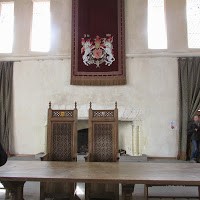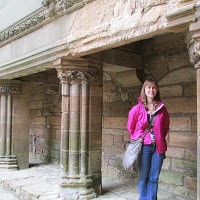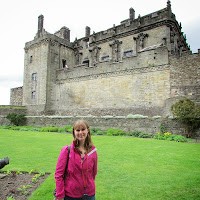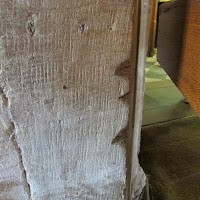Sunday, May 26, 2013
Today, Dad and I set out from Falkirk to visit Stirling Castle, and had time to squeeze in the royal residence and chapel in Linlithgow, too.
Stirling Castle
Geographic Importance
Stirling Castle has been called “a great brooch clasping the lowlands and the highlands together.” Located on a volcanic craig high above the Firth valley, overlooking the Stirling Bridge (until recently the most northerly point at which the Forth river could be crossed), and with stunning views toward the lowland hills and the highland craigs, Stirling is commanding, to say the least.
The castle and its surrounding area have been strategically important since at least the late thirteenth century. In 1297, William Wallace helped defeat an army of King Edward I at the Battle of Stirling Bridge, just below Abby Craig—visible from the ramparts.
The 15th-Century Hall
Visitors to Stirling approach the castle through the gatehouse, which was added in the 1700s in response to the Jacobite threat. Inside, there are two main living structures. The first, the great hall, was built by King James IV in the 1400s, and boasted a minstrel’s gallery, standing candelabra, and two great, throne-like chairs where James and his wife would receive guests.
through the gatehouse, which was added in the 1700s in response to the Jacobite threat. Inside, there are two main living structures. The first, the great hall, was built by King James IV in the 1400s, and boasted a minstrel’s gallery, standing candelabra, and two great, throne-like chairs where James and his wife would receive guests.
The 16th-Century Palace
More impressive, though, is the palace, added later by James IV’s son, James V. The outside of this building was coated in a honey-coloured lime wash known as king’s gold, and features more than 250 carvings. On the outside, facing the inner courtyard, are five statues: James V, looking like an Old-Testament prophet; Ganymede; Venus Armata, having defeated mars and featured using his weapons as playthings; Saturn; and Abundance.
Inside the palace, visitors can see the king’s suite—including his outer chamber, privy chamber, and formal bedchamber. All of these rooms are virtually empty, since James V died before the palace was completed. However, in the king’s first hall, visitors can see replicas of the Stirling heads—carved and painted figures mounted on the ceiling. James is in the second row and fourth from the left. His wives flank him, and King Henry VII of England (depicted with a lion across his shoulders) and Charles V, Holy Roman Emperor, are also in this row. These carvings were meant to show that James V was on a political level with the European and English Kings. The original heads were scattered when the ceiling collapsed. Most of them have been recovered and are now on display in the gallery on the floor above the king’s chamber.
The queen’s chambers connect to the king’s, and are a mirror image of his. Unlike James V, his second wife, Mary of Guise, lived in the castle for more than 30 years after James’ death, and her bedchamber has been made to look as it might have during the 1530s.
From the Queen’s chamber, you can step outside to the Prince’s walk, where some of Stirling’s strangest statues can be viewed on a nearby wall. The audio guide explained that the figures might be meant to represent both physical protection of the people within Stirling’s walls, and moral protection—since the androgynous devil figure is the central position.
In the Queen’s receiving room, there are now replicas of the famous Unicorn Tapestry. While the originals—made in Belgium, and now on display in New York—were not owned by James and Mary, it is known that they had at least one unicorn tapestry of this sort. The tapestries on display here were made by craftspeople working at Stirling and in southern England.
The Chapel
The chapel is where Mary Queen of Scots was baptized and crowned. Her son, James VI of Scotland and I of England, was also baptized here in a golden, jewel-studded font (a gift from his godmother, Elizabeth I). King Charles I also visited the chapel in 1633, and it was in honour of his coming that the frieze near the ceiling was painted (he only stayed for 2 days, and the people of Stirling were very disappointed!)
A Note on accessibility
Stirling Castle had a wonderful audio guide, specifically designed for visually impaired guests. It was wonderful to know what things looked like, as well as what they meant, and to have directions designed to help me navigate the castle. It was still good to have a sighted guide to help me find some of the landmarks the guide sent me looking for, but it was helpful to have something telling me more than “There are statues on the wall,” which is about as much as I would have gotten from Dad! 😉
St. Michael’s Church in Linlithgow
After Stirling Castle, we returned to Linlithgow and visited St. Michael’s Church, which was where the Stewart monarchs worshiped when they were in residence at Linlithgow palace.
Edward I used the church as a storage space for his army in the 1300s, and Oliver Cromwell billeted soldiers and horses here when he attacked Scotland in the 1650s. You can still see grooves in the corner stones where Cromwell’s men sharpened their swords!
Linlithgow Palace
Linlithgow Palace is next door to St. Michael’s church, and is well worth a visit if you have time. The large fountain in the centre of the main courtyard was built by James IV for his Tudor wife, Margaret, though only the mermaid, drummer, and scroll-h older are original, the majority of the fountain having fallen into ruin over the centuries.
older are original, the majority of the fountain having fallen into ruin over the centuries.
The palace itself is in ruins, and the most interesting features are probably the massive fireplaces. This one, located behind what would have been the king’s table in the great hall, had three chimneys, and was big enough for me to stand in (okay, granted, I’m only five feet tall, but still!)
We finished off the day with fish and chips beside Linlithgow loch, so dad could watch people fishing. We’ve just come back to our B&B, and are packing things up to head south again tomorrow.
A Note on the B&B
For the past two days we’ve stayed at a lovely B&B just outside of Linlithgow called Lismore House. I’d highly recommend it if you’re planning on exploring the south of Scotland and have your own transportation—and if you don’t mind sheep and highland cattle 😛 Jacquie, the landlady, is cheerful and wonderfully welcoming; every time we returned to our rooms it was to find some new home-baked goodies waiting alongside a thermos of tea. The fact that I couldn’t see didn’t put her off for an instant, and she was always happy to discuss the day’s plans and make recommendations over breakfast. Thanks for such a wonderful visit, Jacquie!
Northumberland tomorrow!


